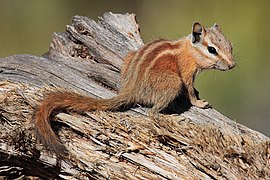啮齿目
| 啮齿目 化石时期:晚古新世 - 现今
| |
|---|---|

| |
| 水豚,现存最大的啮齿动物 | |
| 科学分类 | |
| 界: | 动物界 Animalia |
| 门: | 脊索动物门 Chordata |
| 纲: | 哺乳纲 Mammalia |
| 演化支: | 啮型类 Gliriformes |
| 大目: | 啮形大目 Glires |
| 上目: | 单门齿上目 Simplicidentata |
| 目: | 啮齿目 Rodentia Bowdich, 1821 |
| 亚目 | |
|
松鼠形亚目 Sciuromorpha | |

哺乳动物中百分之四十的物种都属于啮齿目,而且在除了南极洲的其他所有大陆上都可以找到其大量的踪迹。一般常见的啮齿目动物有老鼠、松鼠、花栗鼠、囊鼠、豪猪、河狸、仓鼠、沙鼠、豚鼠、八齿鼠、毛丝鼠、草原犬鼠和美洲旱獭。[1]啮齿目有尖锐的门牙,可以用来啃咬树干、咬碎食物和咬击掠食者。大多数的啮齿目动物以种子或植物为食,但也有少数以昆虫或甚至鱼类为食。一些物种在历史上被视为害兽,会偷吃人类的储粮和传播疾病。
尺寸和范围
编辑以物种种类(但不一定在数量上)来看,啮齿目组成哺乳动物中最大的一目。啮齿目有约2277个物种[3],占了哺乳动物物种数量的百分之四十以上。[4]其优势可能是基于其较小的身体、较短的生育周期和能够啃咬及食用多样的食物。[5]
啮食目在除了南极洲的其他所有大陆和大多数的岛屿中都可以找到其大量的踪迹,且栖息在除了大海的其他所有地方。啮食目是真兽下纲(除了蝙蝠和鳍足类)中唯一不经由人类引入而到达澳洲的动物。
特征
编辑牙齿
编辑啮齿目动物在其上下颚各有一对门牙,这对门牙会不断地生长,且必须靠咬啮来将其持续磨短;而这也是“啮齿目”这一名称的由来。啮齿目的英文学名Rodent就是来自拉丁文rodere(啃)[6][7]。这些牙齿可用来切断树干、咬开果实外皮或做为防卫用途。啮齿目动物的牙齿外面有珐琅质,里面有外露的象牙质,所以可以在咬啮之间自行磨尖。啮齿目动物没有犬牙,在门牙和前臼齿中间留有缝隙。几乎所有的啮齿目动物都以植物为食,尤其是以种子为食,但也有少数例外,会吃昆虫或鱼类。一些松鼠甚至会吃如主红雀科和蓝松鸦等雀形目的鸟类。
体形
编辑许多的啮齿目动物都很小:南非小家鼠的成鼠只会长至6公分长及7公克重,西南亚侏儒跳鼠也有相似或稍小的尺寸。但另一方面,亦有少许啮齿目动物如水豚可重达80公斤[8],而已知最大的啮齿目动物,已灭绝的莫尼西鼠(Josephoartigasia monesi)则估计重约1000公斤,且可能重达1534公斤[9]或2586公斤[10]。
生态和人类的利用
编辑啮齿目在许多生态系统之中都很重要,因为它们繁延迅速,且可做为食肉动物的食物来源、植物传播的途径和疾病的传染媒介。人类把啮齿目动物用来做为毛皮的来源、宠物、动物实验的模式生物和食物,甚至还会用来测试地雷。[11]
非啮齿目的其他目,如翼手目(蝙蝠)、树鼩目(树鼩)、食虫目(鼹鼠、鼩鼱和刺猬)、兔形目(野兔、兔和鼠兔)和食肉目中的鼬科(鼬鼠和水貂)有时会和啮齿目相混淆。
演化
编辑类似啮齿目的哺乳动物的化石纪录开始于恐龙灭绝的六千五百万年前之后不久之时,即古新世时。不过,有些分子钟的资料猜测现今的啮齿目早在白垩纪晚期就已出现,但也有其他分子差异的研究和化石纪录相符。[12][13]到了始新世结束时,河狸的近亲、睡鼠、松鼠和其他类群开始出现于化石纪录之中。一开始是在劳亚大陆(以前北美洲、欧洲和亚洲还连接时的大陆),然后一些物种移居到非洲,形成了最早期的豪猪下目的物种。然而,在科学界里有一小部份的人认为由粒线体DNA可推测豪猪下目可能是属于不同的演化分支,因此应和啮齿目属于不同的目。从非洲,豪猪下目渡海至南美洲(在渐新世和中新世时独立的一块大陆)。到了中新世,非洲撞上了亚洲,使得啮齿目动物如豪猪可以散播到欧亚大陆上。在上新世时,啮齿目的化石出现在澳洲上头。虽然有袋类是澳洲上主要的哺乳动物,啮齿目动物亦在大陆上占了哺乳动物百分之二十五的数量。同时,南北美洲相连了起来,一些啮齿目动物也散布到新的土地上头;老鼠往南走去,豪猪则往北走去。
分类
编辑- 松鼠形亚目 Sciuromorpha
- 豪猪亚目 Hystricomorpha
- 河狸亚目 Castorimorpha
- 鳞尾松鼠亚目 Anomaluromorpha
- 鼠形亚目 Myomorpha
参考文献
编辑- ^ 1.0 1.1 rodent - Encyclopedia.com (HTML). [2007-11-03]. (原始内容存档于2008-12-18).
- ^ Rodents: Gnawing Animals (HTML). [2007-11-03]. (原始内容存档于2007-10-18).
- ^ Wilson, D. E; D. M. Reeder, eds. Mammal Species of the World: A Taxonomic and Geographic Reference. Baltimore: Johns Hopkins University Press. 2005. ISBN 0801882214.
- ^ Myers, Phil. Rodentia. Animal Diversity Web. University of Michigan Museum of Zoology. 2000 [2006-05-25]. (原始内容存档于2006-06-13).
- ^ Lambert, 2000
- ^ Harper, Douglas. rodent. Online Etymology Dictionary.
- ^ Pearsall, J. (编). The Concise Oxford English Dictionary, 10th ed. rev.. Oxford: Oxford University Press. 2002: 1,239. ISBN 0-19-860572-2.
- ^ Capybaras (Hydrochaeridae): Information and Much More from Answers.com. [2008-08-31]. (原始内容存档于2016-09-19).
- ^ Millien, Virginie. The largest among the smallest: the body mass of the giant rodent Josephoartigasia monesi. Proceedings of the Royal Society B. 2008年5月, 1: –1 [2008-05-27]. doi:10.1098/rspb.2008.0087.
- ^ Rinderknecht, Andrés; Blanco, R. Ernesto. The largest fossil rodent (pdf). Proceedings of the Royal Society B. 2008年1月, 275: 923–928 [2008-05-27]. doi:10.1098/rspb.2007.1645.
- ^ Wines, Michael. Gambian rodents risk death for bananas. The Age (The Age Company Ltd.). 2004-05-19 [2006-05-25]. (原始内容存档于2017-09-30). "A rat with a nose for landmines is doing its bit for humanity" Cited as coming from the New York Times in the article.
- ^ Douzery, E.J.P., F. Delsuc, M.J. Stanhope, and D. Huchon. Local molecular clocks in three nuclear genes: divergence times for rodents and other mammals and incompatibility among fossil calibrations. Journal of Molecular Evolution. 2003, 57: S201. doi:10.1007/s00239-003-0028-x.
- ^ Horner, D.S., K. Lefkimmiatis, A. Reyes, C. Gissi, C. Saccone, and G. Pesole. Phylogenetic analyses of complete mitochondrial genome sequences suggest a basal divergence of the enigmatic rodent Anomalurus. BMC Evolutionary Biology. 2007, 7: 16. doi:10.1186/1471-2148-7-16.
延伸阅读
编辑- Adkins, RM; Gelke, R. M. E. L.; Rowe, D.; Honeycutt, R. L. Molecular phylogeny and divergence time estimates for major rodent groups: Evidence from multiple genes. Molecular Biology and Evolution. 2001, 18 (5): 777–791. PMID 11319262.
- Carleton, M. D. and G. G. Musser. 2005. "Order Rodentia," pp. 745–752 in Mammal Species of the World: A Taxonomic and Geographic Reference. Johns Hopkins University Press, Baltimore.
- Leung, LKP; Cox, Peter G.; Jahn, Gary C.; Nugent, Robert. Evaluating rodent management with Cambodian rice farmers. Cambodian Journal of Agriculture. 2002, 5: 21–26.
- McKenna, Malcolm C., and Bell, Susan K. 1997. Classification of Mammals Above the Species Level. Columbia University Press, New York, 631 pp. ISBN 978-0-231-11013-6
- Nowak, R. M. 1999. Walker's Mammals of the World, Vol. 2. Johns Hopkins University Press, London.
- Steppan, S. J.; Adkins, R. A.; Anderson, J. Phylogeny and divergence date estimates of rapid radiations in muroid rodents based on multiple nuclear genes. Systematic Biology. 2004, 53 (4): 533–553. PMID 15371245. doi:10.1080/10635150490468701.
- University of California Museum of Paleontology (UCMP). 2007 "Rodentia". [1](页面存档备份,存于互联网档案馆)
- Wilson, D. E. and D. M. Reeder, eds. 2005. Mammal Species of the World: A Taxonomic and Geographic Reference. Johns Hopkins University Press, Baltimore.
外部链接
编辑- 动物学,骨骼学,比较解剖学:
- ArchéoZooThèque : Rodents osteology : photos sorted by order, family and species
- ArchéoZooThèque : Rodents skeletons drawings: files available in vector, image and PDF formats
- 其他:
- Website on African rodentia(页面存档备份,存于互联网档案馆)
- Rodent Photos(页面存档备份,存于互联网档案馆)
- Rodent Pests(页面存档备份,存于互联网档案馆) chapter in United States Environmental Protection Agency and University of Florida/Institute of Food and Agricultural Sciences National Public Health Pesticide Applicator Training Manual
- Can Rodents be trained not to gnaw?[永久失效链接]